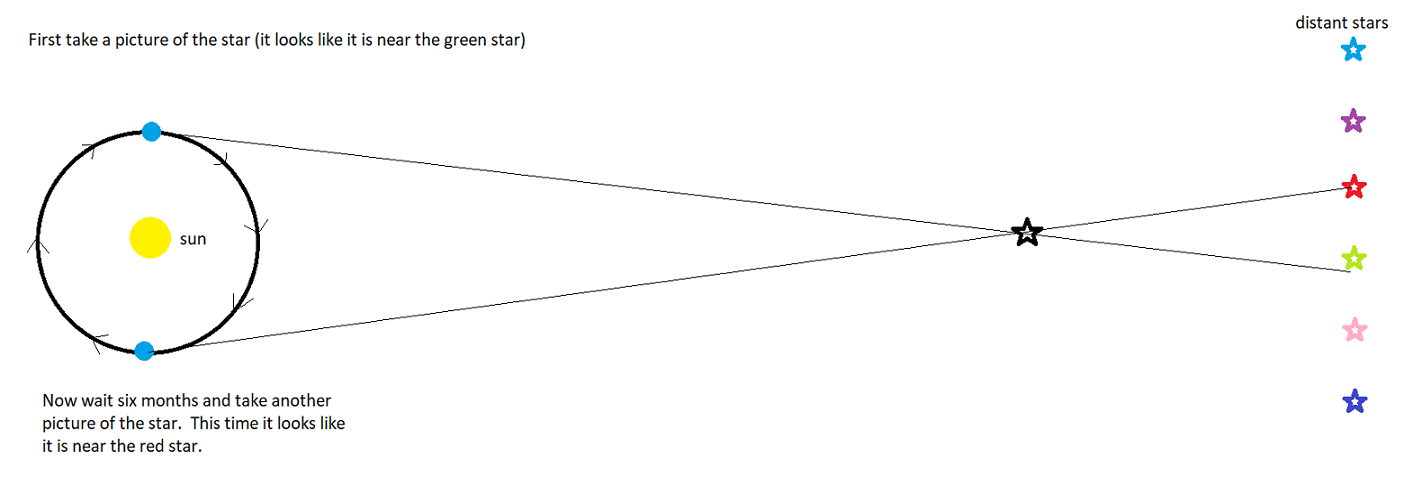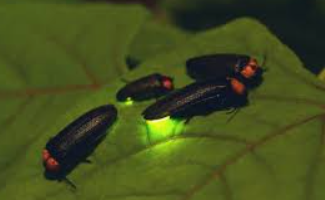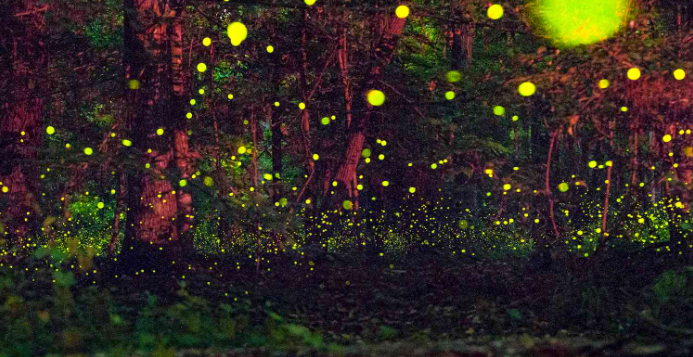
Have you ever looked up in the sky and saw something that stood out and asked yourself ..... How far away is that thing?

Well, when I was your age, I would ask that question a lot. Astronomers, too, ask those same kinds of questions. As it turns out, you will discover all kinds of tricks that will help answer those questions.
You already have a distance measuring trick that you probably never thought about .... YOUR EYES. Oh sure, you already know you use your eyes to see things but did you ever wonder why you have TWO eyes? With two eyes you have everything you need to judge how far away things are ... and nobody had to tell you how its done. You just know it. The trick here is that one eye sees the world just a tiny bit different than what the other eye sees. So here is an experiment you can try:
1. Hold your hand out and stick up your thumb (and hold it
steady) 
2. Now look at your thumb and wink your eyes back and forth

3. What did you notice? Write down what you notice and scroll down to see an answer ....
keep scrolling ....
keep scrolling ....
keep scrolling ....
Did it look like your thumb was moving back and forth? If that's what you said (or something like that) .... you are correct!!! But your thumb wasn't moving, right? Now I want you to try another experiment.
Do exactly the same thing but this time move your thumb closer to your head, hold it very steady, and wink your eyes back and forth. What did you observe? Scroll down to see an answer.
keep scrolling ....
keep scrolling ....
keep scrolling ....
Did you say the shift of your thumb increased? If you said something like that, you are correct! Now the cool thing here is that without even knowing it, you can instantly determine distance using this trick (which is called parallax). You have been doing it your whole life and nobody had to teach you how it was done. Your brain instantly sees a bigger shift for close things and less of a shift from things that are further away. But there is a problem in how good this trick works. Try the same thing but this time move your thumb 10 feet away. What did you notice? ... scroll down
keep scrolling ....
You can stop scrolling. That was a joke! But you CAN use a friend to help you by having them hold up their thumb. You will notice the further away the thumb is, the less "shift" you can detect until EVERYTHING just looks too far away.
Early uses of this trick
In the old days before guns or cannons, when people were fighting each other by hurling rocks at each other, this "trick" came in handy.
 This is a
catapult, a device to hurl rocks at the castle wall to break it down.
Now if an army came a very long way to hurl rocks at the other guys, you
certainly didn't want to waste rocks by missing the wall. They wanted to
be far enough away so the enemy couldn't hurt them with their bows and arrows.
So they had an idea. They would place two soldiers on either side of the
catapult and they would measure angles to their target. Then use math to
determine just how far away the wall was.
This is a
catapult, a device to hurl rocks at the castle wall to break it down.
Now if an army came a very long way to hurl rocks at the other guys, you
certainly didn't want to waste rocks by missing the wall. They wanted to
be far enough away so the enemy couldn't hurt them with their bows and arrows.
So they had an idea. They would place two soldiers on either side of the
catapult and they would measure angles to their target. Then use math to
determine just how far away the wall was.

Soldier 1 would measure angle A and soldier 2 would measure angle B. Then another soldier (who was very good in math) could tell you how far away the target was. This way, the army knew how far the rock needed to fly to break down the castle wall.
And the best part was, the person doing the math probably didn't have to fight (so study your math)!
Was this the first time this trick was used? No way! A guy named Ptolemy did the same thing except he did it to determine how far away the moon was from the earth. Maybe the craziest part of this whole story was WHEN Ptolemy did it ... about 2,000 years ago!!!
This parallax trick can even find the distance to some of the close stars. To do this correctly, you needed a pretty powerful telescope and a lot of patience. It wasn't until 1838 that a fellow named Fredrick Bessel first found the distance to a close star. Bessel took a picture of a star that he thought was pretty close to us and then took another picture six months later. Why wait six months? Take a guess and scroll down to see the answer.
keep scrolling ....
keep scrolling ....
keep scrolling ....
This was a hard one to answer but you are very, very smart if you even got close to the right answer. In six months, the earth moves from one side of the sun to the other side. Then Bessel just did the same thing that the guys tossing rocks at the castle did.

On to something else ....
Let's change subjects for a moment and think about fireflies

We can start by seeing how you answer these questions about fireflies:
Scroll down to see the answer ....
Keep scrolling ...
Keep scrolling ...
Here are my answers. Let's see if we agree.
1. I loved going out to catch fireflies as a kid. I would put them in a glass jar, put some holes in the top of the lid so they could breath, put in some grass so they would feel at home. I would keep them overnight by my bed and then free them the next morning. I hope you have done the same thing. There is no right or wrong answer.
2. All the fireflies I've ever seen make the same color light - green
3. When trying to catch a firefly, I noticed they make a flash every 10 - 20 seconds so my answer is several times in a minute
4. I've never caught a monster sized or super small firefly ... they were all about the same to me
5. Of all the fireflies I've ever seen, they all make about the same amount of light.
If you agree with my answers, here is a picture I want to show you:

This is a picture someone took in a forest. First we have to pretend that all the green dots of light were made by fireflies. If that is the case, can you guess which fireflies are real close to the camera and which ones are very far away? Make a guess and scroll down to see if we agree. Also please try to explain why you believe you are right.
keep scrolling ....
keep scrolling ....
keep scrolling ....

Do you agree with me? My reasoning is that since all fireflies make about the same amount of light, then bright flashes in the picture must mean they are close to the camera and very dim flashes mean they must be far away.
Give yourself a pat on the back if you said something like that.
One last question about fireflies. But let's watch a short video by Calvin Mattheis before we get to that question.
Click here to watch that video and then come back.
When looking at the picture I showed you before, I asked you to pretend that all the light flashes came from fireflies. I could have lied about that! However, if you had a video instead of a picture, what would you notice in that video that would convince you that you were actually watching fireflies and not green Christmas lights?

scroll down ....
scroll down ....
scroll down ....
There are many things you might notice (in a video) to convince you those flashes came from fireflies. First, you would notice they are flashing on and off. Good .... but Christmas light can also flash! But wait, Christmas lights flicker on a very regular schedule and fireflies flash on a much more irregular pattern. Maybe you said the flashing things are moving. Now that's a good one! Christmas lights don't generally move. Maybe you said they are not hanging on a tree ... or you saw no wires ... or you saw one land on someone's arm. All good observations. Maybe you said something that I didn't think of. But the point is, you need to observe things carefully, and make a good argument based on what you saw to conclude those flashes actually came from fireflies. Guess what ... that is exactly how science works. People watch things and based on what is observed, they make conclusions (ideas) that may or may not be correct. Over time, other people will see the same thing and observe something that was missed. Maybe that thing they observe would convince people the idea was correct .. or perhaps, it was wrong. That's OK too. That is how we learn about things in nature.
Hey, let's talk about one more thing before we finish. Astronomers believe they found their own version of fireflies in the sky in a type of star called an RR Lyrae. These stars flash just like fireflies (actually get slightly brighter and then dimmer over time), they ALL produce about the same amount of light (just like fireflies), they are easy to distinguish from other stars (just like fireflies), ... and astronomers can use them to guess just how far away they are (just like you did with fireflies). If an astronomer sees a very dim RR Lyrae star, they know it must be very far away. If the RR Lyrae appears very bright, it must be much closer to us. Pretty cool, eh?

How good are your eyes? I've place three RR Lyrae stars somewhere in this picture. Can you find them all? If you do, can you guess which one is closest to us?
Scroll down for the answer ....
keep scrolling ...
keep scrolling ...

I hope you enjoyed this lesson about finding distances to some things in the sky. If you want to learn more, just keep studying math and science and maybe one day you will take an astronomy class.
References:
Ancient Greek Astronomy: The Distance to the Moon and the Sun Ancient Greek Astronomy: Erkal, Denis 2016/9/7 Public Talks @ University of Cambridge, UK https://people.ast.cam.ac.uk/~derkal/files/public_talks/ancient_greek_astronomy.pdf
RR Lyrae Variables R Nave Georgia State University (n. d.) http://hyperphysics.phy-astr.gsu.edu/hbase/Starlog/rrlyrae.html